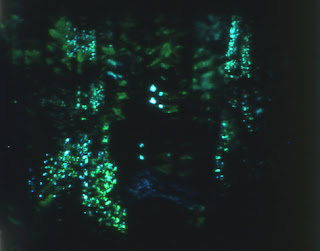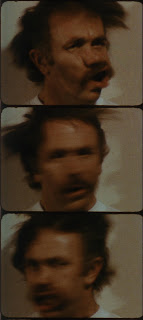PRESERVATION INSANITY has moved!
Please visit its new location at (and reset your bookmarks to):
 |
| Later That Same Night (1971) by Will Hindle |
This'll be a somewhat basic post, covering two of the Will Hindle films I've been working on lately. (Also working on Pasteur3 (1976), which will perhaps be covered later...)
I have a particular devotion to restoring Will's films, for various reasons. One of those reasons is that Shellie Fleming is amazing and an inspiration to me, and it's the least I can do for someone to whom Will was such an important person. Another is that I really love Will's work, and definitely think its reputation has waned dramatically over the past 35 years, to the point where not very many people today know his work anymore. There are several reasons for this, which I may get into later or elsewhere, but they have nothing to do with the very high quality of the work itself. Yet another is the nature of Will's collection - upon his sudden death, a lot of his originals were spread around at various labs, and his materials were in somewhat of a shambles. Thanks to Shellie, a lot more was saved than otherwise would've been. Also, a few things turned up at labs, still sitting in their vaults after 35 years. But a lot of it was lost, including the originals for the two films I'm discussing here. So Will's stuff has always seemed to me in dire need of care.
Pastorale d'Ete (1959) is Will's first completed personal film, and Later That Same Night (1971) is the first film he fully created and completed in Alabama, where he had planned to build (literally and conceptually) a sort of filmmaking workshop that would be open to other artists.
The originals for both are totally lost. The last known location of the originals for Pastorale d'Ete was Deluxe Labs in Hollywood, and the last known location for Later That Same Night was MPL in Memphis. Nothing ever turned up at either, and in fact MPL stated that any materials not claimed from their vaults were discarded. The original mag soundtrack for Later That Same Night did actually survive in Will's collection, so I at least had access to the original mixed soundtrack in very good quality and condition.
Actually, if the originals for Later That Same Night HAD been available, they may not have been usable anyway. The film uses a variety of stocks, and different processing techniques, including at least one section that seems to clearly have been cut into the originals on color print stock. Most likely, several sequences in the originals would now be moderately-to-totally faded. On the other hand, one 350ft. roll of outtakes that Shellie was able to save are all on 7242 Ektachrome EF daylight, and they look beautiful.
On the other hand, Pastorale d'Ete was shot on Kodachrome and what seems to be Plus-X b/w reversal. 900ft. of outtakes survive, all gorgeous, which is a huge bummer in light of what this says about how nice the cut original must've looked.
So, in order to preserve these films, we just had to work from the best surviving original prints.
In both cases, the best prints were housed at Pacific Film Archive in Berkeley, thanks to a 1960s/70s collector who was particularly a fan of Will's work, and who bought a number of prints from him at that time. She treated them very well, so they remained in quite nice condition, eventually going to PFA. We borrowed these Kodachrome (7387) prints of the films from (the very gracious and helpful) PFA to work from, and they went to Colorlab for duplication.
The original mag and a different print of Later That Same Night were both transferred to provide a sound source and reference, respectively. The mag sounded great, and did represent the correct final mix, which was a relief. In the meantime, Colorlab made a new internegative from the PFA Kodachrome print. We then supplied them a new track negative from the restored sound, and they made a new print, matching the Kodachrome print as closely as possible. After two printing passes, it was approved. And it DOES look great, but of course, duplicating Kodachrome is difficult due to its heavy saturation, contrast, density. But I feel confident that Colorlab did as good a job as is possible, and it really does look excellent.
By the way, I'd like to say here - Later That Same Night always felt to me like a problem film, and a weaker one, in Will's filmography. It was always one of my least favorites, though I still thought it was curious and interesting. But looking at it a number of times now during this project, I've changed my mind quite a bit, and think it's quite good. The soundtrack is fantastic, and the sound/image relationships in particular are powerful and unexpected. As an experimental cinematic look at the generational, social, and political disenfranchisement of youth and youth culture in the late '60s/early '/70s, it's really powerful and sharp, and feels weirdly contemporary now, with definite resonances in the current interest in so-called freak folk and radical/alternative culture, aesthetics, and history.
As for Pastorale d'Ete - though the process here is similar to that of Later That Same Night, it's a bit more difficult. The soundtrack is not so hard to deal with. It's just a recording of the titular piece of music, by Honegger. We transferred the audio from the same print we're using as a picture source.
Some frames scanned from outtakes of Pastorale d'Ete (1959)
The above images (sorry, I only currently have low res versions) give some idea of the classical beauty of Pastorale d'Ete, which is a very elegant and inspired California landscape film.
Unlike Later That Same Night, one of the challenges in duplicating the picture for this film lies in the problematic fact that Will shot the color portions of the film on Kodachrome, and also made his finished release prints on Kodachrome print stock. As a result, the Kodachrome prints are very saturated, and more contrasty than Kodachrome prints made from Ektachrome or other lower contrast originals (such as Later That Same Night). Colorlab's first stab at an internegative was deemed too contrasty to work with. It was made on the recently discontinued 3272 internegative stock, which has now been replaced by 3273, which is essentially a polyester version of the 50D camera negative stock. As of this writing, the second try at a usable internegative is in progress. I have to say, looking at the camera original outtakes for this film is depressing, as it gives me an idea of how nicely the preservation work would come out if we actually had the film's camera original to work from.
A few more images from Later That Same Night:



































